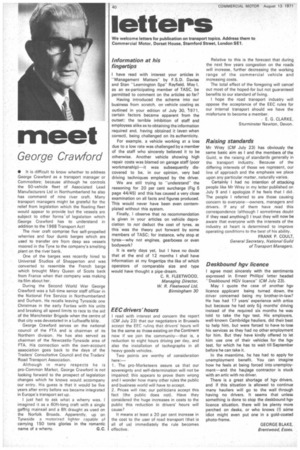meet
Page 42

If you've noticed an error in this article please click here to report it so we can fix it.
George Crawford
• It is difficult to know whether to address George Crawford as a transport manager or Commodore; because although he controls the 50-vehicle fleet of Associated Lead Manufacturers Ltd in Northumberland he also has command of nine river craft. Many transport managers might be grateful for the relief from legislation which the floating fleet would appear to provide but the vessels are subject to other forms of legislation which George Crawford has to understand in addition to the 1968 Transport Act I The over craft comprise five self-propelled wherries and four dumb barges which are used to transfer ore from deep sea vessels moored in the Tyne to the company's smelting plant on the river bank.
One of the barges was recently hired to Universal Studios of Shepperton and was converted to resemble the French barge which brought Mary Queen of Scots back from France when that company was making its film about her.
During the Second World War George Crawford was a full-time senior staff officer in the National Fire Service in Northumberland and Durham. He recalls leaving Tyneside one Christmas in the early Forties with his units and breaking all speed limits to race to the aid of the Manchester Brigade when the centre of that city was devastated in a Luftwaffe blitz.
George Crawford serves on the national council of the FTA and is chairman of its Northern division. He has also served as chairman of the Newcastle-Tyneside area of FTA. His connection with the own-account association goes back to the days of the Traders Consultative Council and the Traders' Road Transport Association.
Although in many respects he is pro-Common Market, George Crawford is not looking forward to the prospect of legislation changes which he knows would accompany our entry. His guess is that it would be five years after entry before we became integrated in Europe's transport set up.
I just had to ask what a wherry was. I imagined it as a 60ft-tong craft with a single gaffrig mainsail and a 6ft draught as used on the Norfolk Broads. Apparently, up on Tyneside a motori7ed lighter capable of carrying 150 tons glories in the romantic name of a wherry. G.C.




















































































